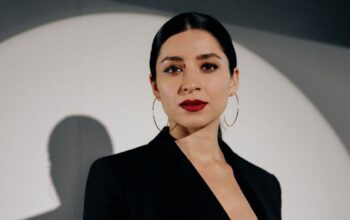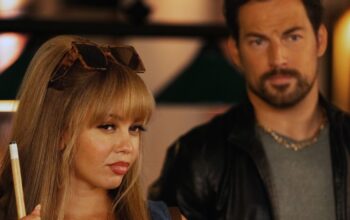DOTA: Dragon’s Blood arrived on Netflix last week, and social media has been ablaze with reactions, fan art, and questions following a cliffhanger ending. Rather than speculating about the series, we went straight to show creator and executive producer, Ashley Miller, to ask him about adapting the popular video-game franchise into an anime series.
If you’re not familiar with Ashley Miller’s credits, he was a writer on TV series such as Fringe, Andromeda, and Terminator: The Sarah Connor Chronicles in addition to penning films like X-Men: First Class and Thor. In Part 1 of our interview, we talk to Ashley about his first foray into writing and producing an animated series, deciding what game elements to include in the story, casting the voice talent, and how this project differs from his previous work.
How did you get involved with this project? And were you familiar with DOTA before working on it?
I got dropped into it while the train was moving. It had been in development for six months, and Studio Mir had done a bunch of concept and character drawings. At that time, it had a very different concept. I went in thinking it was going to be 20 weeks of running a writers’ room, and it turned into, “Hey, if you want to do something else with this, just do it.” So, I sat down and looked at what pieces had been laid out for me.
I’d never played DOTA but I knew what it was. At one point, I was an insane World of Warcraft player. I understood who all of the different game companies were and their games. DOTA seemed really intimidating. Also, it would’ve sucked me in and destroyed my life.
What was your process in deciding what to incorporate from the game while also introducing new elements?
There are a couple of facets to it. The first is, whenever I approach material like this that comes from a video game, as a mental exercise, I try to pretend that the video game is actually an adaptation of some other underlying intellectual property with a story. The powers, the abilities, the rules, and even the setup are abstractions for something else that’s going on under the surface. It’s a way of talking about what people can do and how they do it.
The second thing is really looking at the characters involved. Putting the game aside, I’m looking at these characters and what the game says about their stories and origins. In DOTA, it’s basically two paragraphs per character. For example, Davion was a renowned Dragon Knight. One day when he was minding his own business, he kicked the crap out of an old dragon and hilarity ensued. If you pitched that to me out of the blue, I know how that could be a show. If you pitched Mirana to me, somebody whose entire job was to protect the lotuses from her goddess, and somebody comes in and steals them? I know what that story is going to be. The rest is the scaffolding that goes around it.
In creating DOTA: Dragon’s Blood, how did you strike a balance between appealing to fans of the video game and introducing this world to potential viewers who aren’t familiar with the franchise?
Everybody wants to see and hear and read a good story, right? We’re wired for it. It’s what makes us human. What’s really interesting about DOTA as a game is its lore. There are a lot of facts, but there’s precious little that ties it all together as a story. One thing that you can say about the DOTA player community and their relationship with the lore is there has been this desire to see all of those stories elevated.
My job is looking at those characters, and mentalizing the player who decides to play a character or falls in love with this lore. That is generally the essence of what the material is, and then I have to be true to that essence. The biggest mistake I could have made was taking the names and places, and deciding to do other stuff with it because I couldn’t be bothered to think deeply enough about what it all means to the built-in audience. They’re the barometer. That audience is telling us what they love and what’s meaningful. It’s not the facts or details about what happens in the game. It’s the essence of it.
Did you look to any other anime or fantasy series for inspiration?
Weirdly, at the time that I started this, I was in the middle of doing an adaptation of Red Sonja. So I was deeply into Robert E. Howard and Fritz Leiber and classic writers who wrote things that are very different from what J.R.R. Tolkien and C.S. Lewis were doing. It was really helpful. On paper, you could approach DOTA as a high-fantasy, Tolkien-esque place which feels bloodless. That wasn’t what I wanted to do. I wanted to be in a world where magic is difficult, and it costs something real. When people get hit, it hurts. Superpowers are earned in the most difficult way possible. When really bad things happen, they just happen and it’s awful. That was what I wanted to bring to this series because that was the way to set it apart.
The English voice cast for DOTA includes some of the most well-known voice actors, like Troy Baker and Tony Todd. What was the casting process like, and how big was your role in selecting those actors?
I played a very big role in casting. It was a difficult, exacting process. But I was blessed to have one of the best voice directors in the business, Meredith Layne. We talked about what I wanted from the characters, and listened to a lot of auditions. We consulted with Netflix and Valve (the game developer and publisher), and everybody had opinions. The team didn’t always agree, but ultimately I got the cast that I wanted. It was important to have strong voice actors who understand the art and craft of voice-acting versus casting celebrity voices. Tony Todd is a special case. He voice acts, and he’s already connected to Slyrak in the game, and he’s Tony Todd!
This is your first animated series. Compared to live-action TV shows and films you’ve worked on, did you have to change your approach to developing and writing this story?
I had to unlearn some things and learn some new things. In television, I’ve always been a big fan of the-walk-and-talk, going back to my early days on Andromeda. Walk-and-talks give you movement in a scene. You get dialogue, and it doesn’t feel so locked down. One of the first things I learned on DOTA is that it’s really difficult to animate people walking. It’s a lot of what they call a pencil mile. So I had to figure out how to get around that.
The good thing is that I could blow the doors off of the action. When you write features, you can do really big stuff. DOTA was very different. If you tried to execute the first season as live-action, you’d need a budget equivalent to the GDP of a small European country. Part of the process was breaking out of the limits I would put on myself as a producer. There’s no such thing as too much with animation.
One of the things that got really hammered home for me, as we went through the animatic process, was how to communicate with the team. We had lots of conversations with Studio Mir, the animatic artists, the board artists, and the episodic directors about point of view. Changing a character’s point of view can change the impact and the emotion of a scene even if all of the action beats are the same.
***
In Part 2 of our interview with Ashley Miller, we’ll dive deeper into the characters and storyline in Season 1 of DOTA: Dragon’s Blood, including the overwhelming popularity of Marci, and how the chilling “Praise the Moon of Mene” song came to be.
(This interview was originally posted at the Wiretap Blog. Image Courtesy of Netflix.)



2 thoughts on “A Conversation with DOTA: Dragon’s Blood Executive Producer, Ashley Miller (Part 1)”